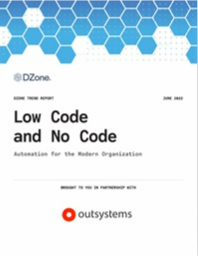Low-Code and No-Code: Automation for the Modern Organization
As the adoption of no-code and low-code development solutions grows, many users have questions around its benefits, flexibility, and overall organizational role. Exploring questions, there is one main benefit that becomes clear: leveraging no-code and low-code practices for automation and speeding time to release.
But what are the pain points that these solutions seek to address? What are the expected vs. realized benefits of adopting a no-code or low-code solution? What are the current gaps that these solutions leave in development practices?
This Trend Report provides expert perspectives to explore these questions. We present a historical perspective on no-code and low-code, offer advice on how to migrate legacy applications to low-code, dive into the challenges of securing no- and low-code environments, share insights into no- and low-code testing, discuss how low-code is playing a major role in the democratization of software development, and more.
Read More
By submitting this form you agree to OutSystems contacting you with marketing-related emails or by telephone. You may unsubscribe at any time. OutSystems web sites and communications are subject to their Privacy Notice.
By requesting this resource you agree to our terms of use. All data is protected by our Privacy Notice. If you have any further questions please email dataprotection@techpublishhub.com
Related Categories: AIM, Applications, Business Process Management, Cloud, Collaboration, Data management, Databases, DevOps, Email, Enterprise Software, ERP, Machine Learning, NAS, Network, SAN, Software


More resources from OutSystems

The Characteristics of Your Future Technology...
Disruption -- whether big (COVID-19) or small (new start-up competitors) -- has more or less become commonplace in any industry. Organisations now ...

Low Code Software Delivers Business Value
In recent years, organizations are realizing the business value of low-code software, including how they solve common development problems like tec...

The Speed of Change: How Fast Are You?
The pandemic crisis and the impact of lockdown have been a massive shock to the global economy and to our daily lives. While a 'new normal' is deve...